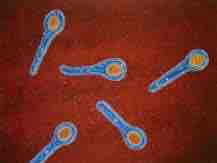Host-pathogen interactions are the interactions that take place between a pathogen (e.g. virus, bacteria) and their host (e.g. humans, plants). By definition, all pathogens damage their host to some extent. Infectious diseases result from the interplay between the pathogens and the defenses of the hosts they infect. The appearance and severity of disease resulting from the presence of any pathogen depends upon the ability of that pathogen to damage the host as well as the ability of the host to resist the pathogen.

Clostridium tetani
Clostridium tetani are pathogenic bacteria.
Clinicians therefore classify infectious microorganisms or microbes according to the status of host defenses - either as primary pathogens or as opportunistic pathogens.
Primary pathogens cause disease as a result of their presence or activity within the normal, healthy host, and their intrinsic virulence is, in part, a necessary consequence of their need to reproduce and spread. Many of the most common primary pathogens of humans only infect humans; however many serious diseases are caused by organisms acquired from the environment or which infect non-human hosts.
Organisms which cause an infectious disease in a host with depressed resistance are classified as opportunistic pathogens. Opportunistic diseases may be caused by microbes that are ordinarily in contact with the host, such as pathogenic bacteria or fungi in the gastrointestinal or the upper respiratory tract, and they may also result from (otherwise innocuous) microbes acquired from other hosts or from the environment as a result of traumatic introduction. An opportunistic disease requires impairment of host defenses, which may occur as a result of several factors such as genetic defects, exposure to antimicrobial drugs or immunosuppressive chemicals, exposure to ionizing radiation, or as a result of an infectious disease with immunosuppressive activity. Primary pathogens may also cause more severe disease in a host with depressed resistance than would normally occur in an immunosufficient host.